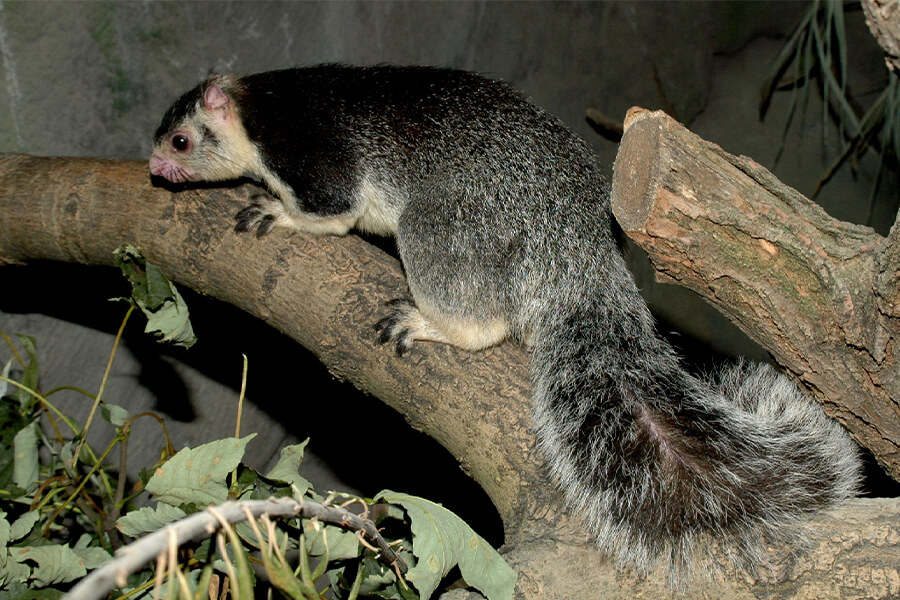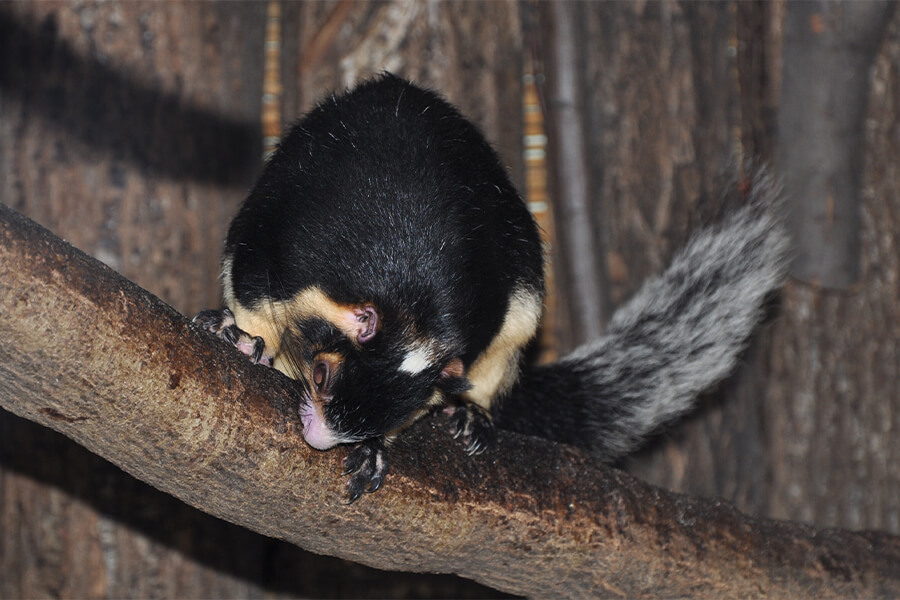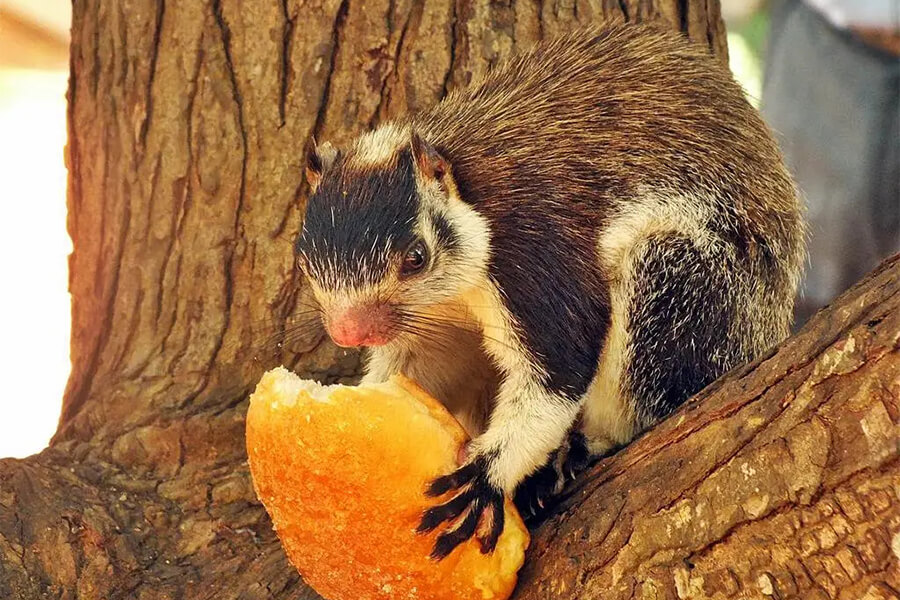For many travelers, wildlife is what transforms a trip from “nice” to unforgettable. Beyond elephants, leopards and whales, Sri Lanka also has a smaller, quieter icon hidden in the treetops: the Sri Lankan giant squirrel. For anyone planning Sri Lanka tours, understanding this species – officially celebrated as the national animal of Sri Lanka – will give you a richer, more meaningful connection with the island’s forests, villages and national parks.
Introduction to the National Animal of Sri Lanka
Walk through a Sri Lankan forest at dawn and you may hear a sharp chatter above your head, followed by a flash of fur and an impossibly long tail gliding between branches. That is the Sri Lankan giant squirrel, Ratufa macroura – widely recognized and celebrated as the national animal of Sri Lanka.
While big cats and elephants often steal the spotlight on safari brochures, this large tree-dwelling squirrel is just as symbolic. It represents the quiet, everyday connection between people, trees and wildlife. For villagers, hikers and birdwatchers, the national animal of Sri Lanka is a familiar presence: a watchful neighbor in temple groves, home gardens and forest edges.
For you as a visitor, learning about the national animal of Sri Lanka turns a distant silhouette in the canopy into a story you can understand: how it lives, why it matters, and how your travel choices can help protect it.
Quick Facts About the Sri Lankan Giant Squirrel
To start, here are some quick facts that explain why the Sri Lankan giant squirrel stands out as the national animal of Sri Lanka:
- Scientific name: Ratufa macroura
- Common names: Sri Lankan giant squirrel, grizzled giant squirrel
- Status: Regionally protected and closely associated with forest conservation
- Size: Body length around 35–45 cm; tail can be as long as or longer than the body
- Weight: Typically 1–1.5 kg
- Habitat: Forests, forest edges, home gardens and plantation–forest mosaics
- Activity: Mainly diurnal (active in daylight), especially mornings and late afternoons
These characteristics make the squirrel highly visible in the treetops, which is one reason it fits well as the national animal of Sri Lankan forests. It’s large enough to notice, distinctive in shape, and strongly linked to healthy tree cover.
Why the Giant Squirrel Is Recognized as the National Animal of Sri Lanka
Countries choose national animals for more than just appearances. In Sri Lanka, the giant squirrel is a powerful symbol because it connects nature, culture and everyday life. As the national animal of Sri Lanka, it represents:
- Forest heritage – The squirrel lives almost entirely in trees, reminding people how crucial forests are for water, climate and rural livelihoods.
- Biodiversity – Sri Lanka is a global biodiversity hotspot, and the national animal of Sri Lankan giant squirrel showcases the uniqueness of island wildlife.
- Cultural familiarity – Unlike some elusive species, villagers and pilgrims often see the national animal of Sri Lanka near temples, reservoirs and spice gardens.
In many schoolbooks and awareness campaigns, children learn to recognize the national animal of Sri Lankan forests early on. This helps foster pride in local wildlife and creates a sense of responsibility to protect the habitats where the giant squirrel lives.
From a traveler’s point of view, knowing that the giant squirrel is the national animal of Sri Lanka encourages you to look up more often – to treat the forest canopy as a living, breathing part of your trip, not just a backdrop for photos.
Biological Overview of the Sri Lankan Giant Squirrel
Scientific Classification and Names (Ratufa macroura)
The Sri Lankan giant squirrel belongs to the squirrel family Sciuridae, which also includes tree squirrels, ground squirrels and chipmunks. Its classification is:
- Kingdom: Animalia
- Phylum: Chordata
- Class: Mammalia
- Order: Rodentia
- Family: Sciuridae
- Genus: Ratufa
- Species: Ratufa macroura
The genus Ratufa contains several species of giant squirrels found across South and Southeast Asia. Among them, Ratufa macroura is the species most closely tied to Sri Lanka, which is why it is commonly highlighted in educational material as the national animal of Sri Lanka.
When you talk to local guides and park naturalists, you’ll often hear both the scientific name and the common name used interchangeably. They know that travelers who are interested in the national animal of Sri Lankan wildlife often appreciate this extra scientific detail.
Physical Characteristics of the National Animal of Sri Lankan Giant Squirrel
The national animal of Sri Lankan giant squirrel is striking when you see it clearly, especially through binoculars in good light. Key characteristics include:
- Impressive size: Much larger than common garden squirrels, with a robust body and strong limbs adapted for climbing and leaping.
- Long, bushy tail: Sometimes longer than the body, the tail acts as a counterbalance and steering tool when the squirrel jumps between branches. It also helps you identify the national animal of Sri Lanka quickly in the treetops.
- Color variations: Coat colors range from grey and brown to cream and buff, with paler underparts. In some regions, the national animal of Sri Lankan forests has more contrasting patterns, while in others it appears more uniformly colored.
- Sharp claws and strong teeth: Perfectly adapted for gripping bark and cracking tough nuts and seeds.
From a distance, first-time visitors sometimes think they are looking at a small monkey because of the animal’s size and the way it moves. Once you notice the rodent-like head and long sweeping tail, you’ll recognize the national animal of Sri Lanka instantly.
Subspecies and Regional Variations in Sri Lanka
Sri Lanka’s climate ranges from wet lowland rainforest to dry-zone scrub and cool upland plateau. This variety has produced subtle regional forms of Ratufa macroura. In different parts of the island, naturalists may refer to local subspecies or “races” based on coat color and distribution.
Although taxonomists continue to refine how these forms are classified, you may notice that the national animal of Sri Lanka you see in a wet-zone forest looks slightly different from the one you spot in a dry-zone park. This is part of the charm of the national animal of Sri Lankan landscapes – the same species, but adapted and shaded to fit its local environment.
If your itinerary includes both hill country and lowland parks, pay attention to these color differences. It’s a fun, non-technical way to appreciate the diversity within the national animal of Sri Lankan giant squirrel populations.
Habitat and Distribution of the National Animal of Sri Lanka
Forest Types and Elevation Ranges
The national animal of Sri Lanka is strongly tied to trees. Wherever there is a tall, connected canopy, the giant squirrel has a chance to thrive. Typical habitats include:
- Lowland rainforests: Evergreen forests with dense canopies, plenty of fruiting trees and high humidity. These are classic strongholds for the national animal of Sri Lankan wet-zone.
- Moist and dry monsoon forests: Seasonal forests where the mix of evergreen and deciduous trees still offers enough cover and food.
- Riverine forests and tank bunds: Trees lining rivers, reservoirs and ancient irrigation tanks often support the national animal of Sri Lanka, especially where older trees are preserved.
- Home gardens and mixed plantations: In rural areas, coconut, jackfruit, mango and spice trees can form a “secondary canopy” that the national animal of Sri Lankan villages can use as habitat and feeding grounds.
In terms of altitude, the giant squirrel is mostly found from the lowlands up to mid-elevations. In cool, high-elevation cloud forests, it can still appear, but sightings are less frequent and more localized.
Key National Parks and Wildlife Areas to See the Giant Squirrel
Although you can sometimes see the national animal of Sri Lanka right beside a quiet village road, national parks and reserves give you the best chance of consistent sightings. Popular locations include:
- Sinharaja Forest Reserve: A UNESCO-listed rainforest that is a highlight of many nature-focused itineraries. Early morning walks commonly reveal the national animal of Sri Lankan rainforests moving high in the canopy.
- Horton Plains National Park: In the central highlands, you may spot the national animal of Sri Lanka along forest edges or near wooded sections of trails. Its calls often give away its presence before you see it.
- Udawalawe and Wasgamuwa: Known for elephants, these parks also contain riverine and gallery forests where the national animal of Sri Lankan dry-zone can be found. Ask your guide to watch the treetops during jeep safaris.
- Knuckles Conservation Forest: A more off-the-beaten-path destination where hikers can look for the national animal of Sri Lankan giant squirrel in mixed montane and sub-montane forests.
In well-organized wildlife tours, guides will often know specific fruiting trees, fig groves or canopy gaps where the national animal of Sri Lanka is regularly observed. If you’re keen, let your guide know at the start of the day so they can factor the national animal of Sri Lankan sightings into your route.
Coexistence of Humans and the National Animal of Sri Lankan Forests
One reason the giant squirrel works so well as the national animal of Sri Lanka is that it still lives relatively close to people in many regions. Villages that retain large shade trees around homes, temples and water bodies often host the national animal of Sri Lankan canopy.
However, this coexistence relies heavily on maintaining tree cover. When large trees are removed for timber, fuel or development, the continuous canopy breaks. The national animal of Sri Lanka then has to cross on the ground or use power lines, exposing it to predators, accidents and conflict.
As a responsible traveler, you can:
- Choose eco-lodges and guesthouses that protect mature trees on their land.
- Support community-based tourism projects that promote forest conservation.
- Avoid disturbing or trying to feed the national animal of Sri Lankan wildlife.
By doing so, you help create economic incentives for local communities to keep the canopy intact – which directly benefits the national animal of Sri Lankan giant squirrel and many other species.
Behavior and Diet of the Sri Lankan Giant Squirrel
Behaviorally, the national animal of Sri Lanka is an active, alert and surprisingly vocal animal once you know what to listen for. It is primarily diurnal, with activity concentrated in the cooler hours of the day.
In the early morning, you might see the national animal of Sri Lankan forests moving along high branches, foraging for fruits and seeds. It uses its long tail as a balancing pole, often pausing to sit upright and nibble while keeping an eye on its surroundings. During the heat of midday, it usually rests in well-shaded spots, relying on its camouflage to remain invisible to predators and human observers.
Socially, the Sri Lankan giant squirrel is more solitary than many smaller squirrels. Most sightings involve single individuals or pairs rather than large groups. Each animal maintains a home range and communicates with neighbors through a variety of calls – short, sharp barks or chattering sounds that carry surprisingly far through the canopy. When a predator or unfamiliar person is nearby, the national animal of Sri Lanka may issue loud alarm calls and flick its tail before retreating into denser foliage.
Its diet is largely plant-based, but quite varied:
- Fruits and seeds: Jackfruit, mango, figs, berries and other forest fruits form the bulk of its diet. By eating fruits and dispersing seeds, the national animal of Sri Lankan forests contributes to natural regeneration.
- Nuts and buds: Tough seeds and nuts are cracked open with strong rodent teeth, while buds and young shoots provide additional nutrients.
- Occasional animal matter: In some cases, the national animal of Sri Lanka may supplement its diet with insects, bird eggs or other small sources of protein, especially when fruit is scarce.
For travelers who enjoy wildlife watching, a few practical tips will enhance your experience with the national animal of Sri Lankan canopy:
- Be patient and listen: Often you will hear rustling leaves, falling fragments of fruit or sharp calls before you see anything. Use those sounds as clues.
- Use binoculars or a zoom lens: The national animal of Sri Lanka usually stays high in the trees. Good optics make a huge difference in how much detail you can appreciate.
- Keep a respectful distance: Avoid clapping, shouting or trying to attract the animal with food. Natural behavior is more interesting – and your presence should not cause stress to the national animal of Sri Lankan giant squirrel.
By the time you leave Sri Lanka, you may look back and realize that some of your favorite moments weren’t just about big game sightings, but about quiet minutes spent under a tall tree, watching the national animal of Sri Lanka leap effortlessly from branch to branch – a small but powerful symbol of the island’s living, breathing forests.





